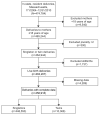Severe Maternal Morbidity and the Use of Assisted Reproductive Technology in Massachusetts
- PMID: 26855105
- PMCID: PMC4764424
- DOI: 10.1097/AOG.0000000000001292
Severe Maternal Morbidity and the Use of Assisted Reproductive Technology in Massachusetts
Abstract
Objective: To assess whether risk of severe maternal morbidity at delivery differed for women who conceived using assisted reproductive technology (ART), those with indicators of subfertility but no ART ("subfertile"), and those who had neither ART nor subfertility ("fertile").
Methods: This retrospective cohort study was part of the larger Massachusetts Outcomes Study of Assisted Reproductive Technology. To construct the Massachusetts Outcomes Study of Assisted Reproductive Technology database and identify ART deliveries, we linked ART treatment records to birth certificates and maternal and infant hospitalization records occurring in Massachusetts between 2004 and 2010. An algorithm of International Classification of Diseases, 9th Revision, Clinical Modification diagnosis and procedure codes identified severe maternal morbidity. We used logistic generalized estimating equations to estimate odds of severe maternal morbidity associated with fertility status, adjusting for maternal demographic and health factors and gestational age, stratifying on plurality and method of delivery.
Results: The prevalence of severe maternal morbidity among this population (n=458,918) was 1.16%. The overall, crude prevalences of severe maternal morbidity among fertile, subfertile, and ART deliveries were 1.09%, 1.44%, and 3.14%, respectively. The most common indicator of severe maternal morbidity was blood transfusion. In multivariable analyses, among singletons, ART was associated with increased odds of severe maternal morbidity compared with both fertile (vaginal: adjusted odds ratio [OR] 2.27, 95% confidence interval [CI] 1.78-2.88; cesarean: adjusted OR 1.67, 95% CI 1.40-1.98, respectively) and subfertile (vaginal: adjusted OR 1.97, 95% CI 1.30-3.00; cesarean: adjusted OR 1.75, 95% CI 1.30-2.35, respectively) deliveries. Among twins, only cesarean ART deliveries had significantly greater severe maternal morbidity compared with cesarean fertile deliveries (adjusted OR 1.48, 95% CI 1.14-1.93).
Conclusion: Women who conceive through ART may have elevated risk of severe maternal morbidity at delivery, largely indicated by blood transfusion, even when compared with a subfertile population. Further research should elucidate mechanisms underlying this risk.
Figures
Similar articles
-
Birth outcomes of singleton vaginal deliveries to ART-treated, subfertile, and fertile primiparous women.J Assist Reprod Genet. 2018 Sep;35(9):1585-1593. doi: 10.1007/s10815-018-1238-x. Epub 2018 Jun 20. J Assist Reprod Genet. 2018. PMID: 29926374 Free PMC article.
-
Pregnancy, birth, and infant outcomes by maternal fertility status: the Massachusetts Outcomes Study of Assisted Reproductive Technology.Am J Obstet Gynecol. 2017 Sep;217(3):327.e1-327.e14. doi: 10.1016/j.ajog.2017.04.006. Epub 2017 Apr 8. Am J Obstet Gynecol. 2017. PMID: 28400311 Free PMC article.
-
Hospitalization before and after delivery in fertile, subfertile, and ART-treated women.J Assist Reprod Genet. 2019 Oct;36(10):1989-1997. doi: 10.1007/s10815-019-01562-2. Epub 2019 Aug 14. J Assist Reprod Genet. 2019. PMID: 31414316 Free PMC article.
-
Trends in Severe Maternal Morbidity After Assisted Reproductive Technology in the United States, 2008-2012.Obstet Gynecol. 2016 Jan;127(1):59-66. doi: 10.1097/AOG.0000000000001197. Obstet Gynecol. 2016. PMID: 26646124 Free PMC article.
-
Pregnancy and birth outcomes in couples with infertility with and without assisted reproductive technology: with an emphasis on US population-based studies.Am J Obstet Gynecol. 2017 Sep;217(3):270-281. doi: 10.1016/j.ajog.2017.03.012. Epub 2017 Mar 18. Am J Obstet Gynecol. 2017. PMID: 28322775 Free PMC article. Review.
Cited by
-
Pregnancy outcomes in women with endometriosis and/or ART use: a population-based cohort study.Hum Reprod. 2022 Sep 30;37(10):2350-2358. doi: 10.1093/humrep/deac186. Hum Reprod. 2022. PMID: 36018266 Free PMC article.
-
The risk of perinatal and cardiometabolic complications in pregnancies conceived by medically assisted reproduction.J Assist Reprod Genet. 2024 Mar;41(3):613-621. doi: 10.1007/s10815-024-03025-9. Epub 2024 Jan 20. J Assist Reprod Genet. 2024. PMID: 38244153 Free PMC article.
-
Birth outcomes of singleton vaginal deliveries to ART-treated, subfertile, and fertile primiparous women.J Assist Reprod Genet. 2018 Sep;35(9):1585-1593. doi: 10.1007/s10815-018-1238-x. Epub 2018 Jun 20. J Assist Reprod Genet. 2018. PMID: 29926374 Free PMC article.
-
Severe maternal morbidity: A population-based study of an expanded measure and associated factors.PLoS One. 2017 Aug 7;12(8):e0182343. doi: 10.1371/journal.pone.0182343. eCollection 2017. PLoS One. 2017. PMID: 28787028 Free PMC article.
-
Pregnancy, birth, and infant outcomes by maternal fertility status: the Massachusetts Outcomes Study of Assisted Reproductive Technology.Am J Obstet Gynecol. 2017 Sep;217(3):327.e1-327.e14. doi: 10.1016/j.ajog.2017.04.006. Epub 2017 Apr 8. Am J Obstet Gynecol. 2017. PMID: 28400311 Free PMC article.
References
-
- Centers for Disease Control and Prevention. Division of Reproductive Health, National Center for Chronic Disease Prevention and Health Promotion [Accessed July 14, 2015];Pregnancy Mortality Surveillance System. 2014 http://www.cdc gov/reproductivehealth/maternalinfanthealth/pmss html [serial online]
-
- Callaghan WM, Creanga AA, Kuklina EV. Severe maternal morbidity among delivery and postpartum hospitalizations in the United States. Obstet Gynecol. 2012;120:1029–1036. - PubMed
-
- Sunderam S, Kissin DM, Crawford SB, Folger SG, Jamieson DJ, Barfield WD. Assisted reproductive technology surveillance--United States, 2011. MMWR Surveill Summ. 2014;63:1–28. - PubMed
-
- Wright VC, Schieve LA, Reynolds MA, Jeng G, Kissin D. Assisted reproductive technology surveillance--United States, 2001. MMWR Surveill Summ. 2004;53:1–20. - PubMed
-
- Chandra A, Copen CE, Stephen EH. Infertility service use in the United States: Data from the National Survey of Family Growth, 1982–2010. National Center for Health Statistics; Hyattsville, MD: 2014. National health statistics reports; no 73. 2014. - PubMed
Publication types
MeSH terms
Grants and funding
LinkOut - more resources
Full Text Sources
Other Literature Sources
Medical


